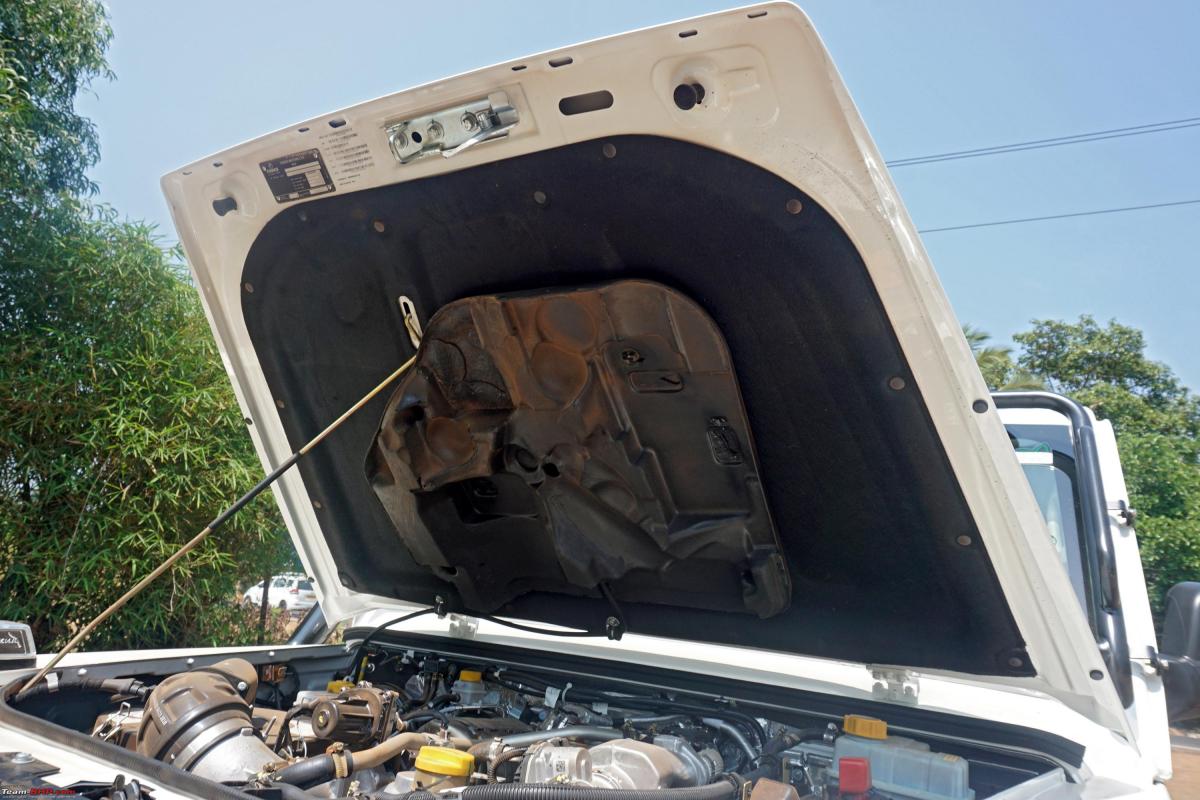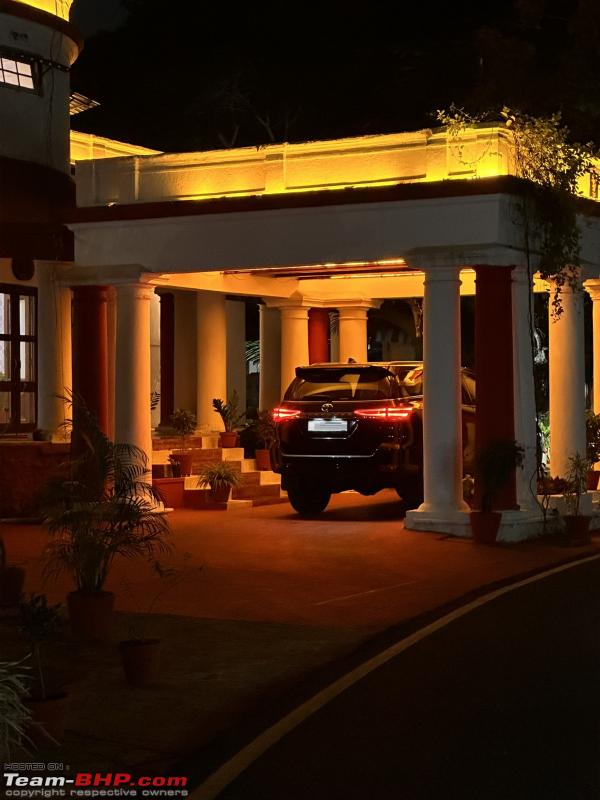The Gurkha gets an independent double wishbone suspension with coil springs at the front and a multilink suspension with a Panhard rod and coil springs at the rear. It now rides on 18-inch wheels with 255/65 section tyres. The low-speed ride quality is good for a ladder-on-frame off-roader.
Driving the 2.6L Diesel 5-speed MT
2,596cc, 4-cylinder diesel engine puts out 138 BHP & 320 Nm:

The 2024 Gurkha retains the same 2.6-liter, 4-cylinder diesel engine as the outgoing car. However, the unit has been retuned to deliver more power and torque. It now develops 138 BHP @ 3,200 rpm and 320 Nm @ 1,400-2,600 rpm. These figures are considerably higher than the 90 BHP & 250 Nm of the outgoing car. But even with the additional power, the Gurkha does not feel sporty to drive on the road.
To fire up the engine, you do not need to press the clutch anymore. On start-up, there is some body shake, and at idle, vibrations are felt on the steering wheel, pedals, handbrake, and seats.
Release the clutch gradually and the car moves forward without any throttle input. You can even pull away from a standstill in 2nd, albeit with some extra throttle input. Throttle response is satisfactory and power comes in smoothly. Low-speed drivability is fair and in the lower gears, the car can pull reasonably well at anything over 1,000 rpm. The engine starts feeling comfortable above ~1,250 rpm. Keeping up with the city traffic is not difficult, but if you need to close a gap, a downshift might be required.
On the open road, the Gurkha is a little quicker than before thanks to its higher power and torque output. However, it still isn’t what we would call fast or even brisk. Due to its heavy kerb weight, the 5-door takes its own sweet time to accelerate. On the roads of Goa, I managed to get it past 80 km/h on a few occasions, but only just. The lighter 3-door feels slightly quicker. Still, it’s not fast by any means. Something like the Mahindra Thar will leave the Gurkha in its dust. Overtaking slower vehicles on undivided highways will require some planning and aggressive downshifting. The turbo kicks in ~2,000 rpm and pulls nicely till 3,000 rpm. When pushed, the engine revs to 3,500 rpm. This is very low and you might need to upshift in the middle of overtaking manoeuvres. The Gurkha is more suited to a sedate driving style. It can cruise at 80 km/h in 5th gear with the tachometer reading ~1,750 rpm.
The clutch is light with a pedal travel that’s neither too long, nor too short. The transmission has been changed. The outgoing vehicle’s gearbox could handle just 250 Nm of torque. With the torque increased to 320 Nm, Force Motors had to use the 5-speed MT of the erstwhile Gurkha Xtreme. This gearbox has long throws and a notchy shift action. It’s not suitable for snappy shifting. There is also a clicking noise heard every time you move to neutral from any gear.
The Gurkha also gets a drive mode selector. While Power is the default mode, one can select the Eco mode by pressing a button on the centre fascia. In Eco mode, the throttle response is dumbed down and the car feels very sluggish. While it is alright to use Eco mode in the city in slow-moving traffic, if you want to close a gap to the car in front quickly, you will need to shift to Power mode. Eco mode is not suitable for highway driving at all.
Apart from the drive mode selector, the Gurkha gets an idling start/stop function to improve fuel efficiency. This feature worked seamlessly on our short test drive and was not intrusive. It can be turned off by pressing a button on the centre fascia.
Coming to NVH, the engine can be heard inside the cabin at all times. It is louder as you accelerate. Above 3,000 rpm, the engine starts screaming and begging for an upshift. Wind noise is not heard at 80 km/h, but tyre noise is present at even 60 km/h. There is a prominent body shake on start-up and shutdown. As mentioned earlier, vibrations can be felt on the steering wheel, seat, and pedals at idle. The gear lever moves as you accelerate as well.
Lots of insulation under the bonnet:

Suspension

Ride Comfort
The Gurkha gets an independent double wishbone suspension with coil springs at the front and a multilink suspension with a Panhard rod and coil springs at the rear. It now rides on 18-inch wheels with 255/65 section tyres. The low-speed ride quality is good for a ladder-on-frame off-roader. The independent suspension is very competent while handling small to medium-sized potholes and bumps. There is of course some side-to-side movement in the cabin, yet in comparison with some of the other off-roaders, the Gurkha was impressive.
Handling & Dynamics
High-speed stability is acceptable. The maximum speed that we could achieve on the roads of Goa was just a little over 80 km/h. The Gurkha didn’t feel nervous at any point.
However, going around corners is a different ballgame. The Gurkha is a tall vehicle and there is a lot of body roll. Do remember that this is an off-roader and not very good at cornering. In the interest of safety, I did not push the car hard through the country roads with multiple blind corners. Anyway, it’s not a car that likes to be driven fast.
Steering
The hydraulic power steering is not as light as the electric units in modern cars at parking or crawling speeds. Those who are used to modern EPS systems will inevitably complain. Once the speedometer needle climbs, the steering does feel easier to operate. It also offers sufficient weight on the highway.
Braking
This Gurkha comes with the ubiquitous front disc & rear drum braking hardware. The brakes are equipped with ABS + EBD. We feel that the brakes bite too late. The pedal travel is long and even after the brakes bite, they are not strong. They certainly do not inspire confidence.
Niggles & Problems
While the Gurkha has largely remained the same, Force has added some more electronics to it. And the chances of things going wrong with new electronics are generally high. On one of the test cars, the reversing camera kept getting engaged and the navigation on our test car wasn’t working. From experience, I can say that shift-on-the-fly systems are not as robust as manual transfer cases. We highly recommend that you do a thorough PDI and make sure that your car is free of any niggles or issues.
Continue reading the discussion on the Force Gurkha 5-Door on our forum.






